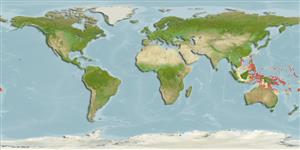Classification / Names
Common names | Synonyms | Catalog of Fishes (gen., sp.) | ITIS | CoL | WoRMS | Cloffa
Actinopterygii (ray-finned fishes) >
Perciformes (Perch-likes) >
Gobiidae (Gobies) > Gobiinae
Etymology: Trimma: Greek, trimma, -atos = something crushed (Ref. 45335); cana: Specific epithet is an arbitrary combination of letters embodying the first three letters of both the English words 'candy' and 'cane'; an allusion to adding red bands to a white candy formed in the shape of a shepherd's crook. An noun in apposition.. More on author: Winterbottom.
Environment / Climate / Range
Ecology
Marine; demersal; depth range 12 - 35 m (Ref. 90102). Tropical, preferred ?
Western Pacific: Philippines, Caroline Is., Fiji, Marshall Is., and Palau
Size / Weight / Age
Maturity: Lm ? range ? - ? cm
Max length : 2.5 cm SL male/unsexed; (Ref. 52975)
Dorsal
spines
(total): 7;
Dorsal
soft rays
(total): 9-10;
Anal
spines: 1;
Anal
soft rays: 8 - 10. Diagnosis: White background with 8 distinct vertical bars on head and body; yellow spots on the medial fins; a well-defined dark bar across the postorbital region of the skull (may be partially obscured by the overlying anterior extension of the epaxialis body musculature in larger specimens). No scales on head. Opercle, cheek, or nape. A second dorsal spine varying from slightly to very elongate (as far as the mid-peduncle). A well-developed interorbital trench. A variably-developed postorbital trench (usually developed). A fifth pelvic fin ray which is unbranched and 50-85% of the fourth.
Solitary or in small groups on surface of hard corals. Inhabits steep outer reef slopes in 12-35 m (Ref. 90102).
Life cycle and mating behavior
Maturity | Reproduction | Spawning | Eggs | Fecundity | Larvae
Winterbottom, R., 2004. Three new species of Trimma (Pisces: Gobiidae) from the central, western and south Pacific. Aqua J. Ichthyol. Aquat. Biol. 9(1):7-16. (Ref. 52975)
IUCN Red List Status (Ref. 115185)
CITES (Ref. 94142)
Not Evaluated
Threat to humans
Harmless
Human uses
More information
Common namesSynonymsMetabolismPredatorsEcotoxicologyReproductionMaturitySpawningFecundityEggsEgg development
ReferencesAquacultureAquaculture profileStrainsGeneticsAllele frequenciesHeritabilityDiseasesProcessingMass conversion
Tools
Can't connect to MySQL database fbquizv2. Errorcode: Too many connections
